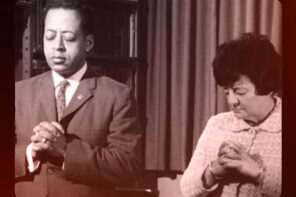From Fifth Avenue to Dorchester Heights, this St. Patrick’s Day will feature the traditional uilleann pipers and Irish step dancers; in Chicago the river will be dyed green, and in Washington DC the Taoiseach will present the president with a Waterford Crystal filled with shamrocks. We’ll see kitschier associations as well, from “Kiss Me I’m Irish” t-shirts to full-grown adults cosplaying as leprechauns.
Clergy have expressed concern about secular revelry obscuring the religious significance of what, after all, is a saint’s day. Fr. Ryan Jones, an Episcopal priest at the Eucharist Church in San Francisco, wrote last year that while he’d long dismissed the holiday as “an excuse for people to get sloshed on green beer or talk about leprechauns and four leafed clovers,” he’s come to see St. Patrick’s Day as a “powerful means of enfleshing the gospel.” For Jones, his appreciation for the saint was inculcated in the community of which he’s a member, an ecumenical fellowship named after a two kilometer-long isle, with a population a bit over a hundred, located in the Inner Hebrides off the west coast of Scotland.
Iona is the veritable navel of Celtic Christianity. Rocky-shored with low green hills clustered in its small interior, the Isle of Iona was where the Irish Abbot St. Columba established his monastery in the sixth-century, a community intended for monks who would produce illuminated manuscripts in their scriptorium by the rhythm of the daily liturgy, living a life of prayer and contemplation before being buried beneath the numerous stone Celtic crosses that still line the shores. Columba never met the more famous Patrick, but Iona’s founding evidences the latter’s piety.
Ironically, it was Columba’s grandfather, the pagan king Nial, who was responsible for Patrick’s kidnapping, the event which began the saint’s ministry in Ireland. Now, both Patrick and Columba are among the dozen canonized Disciples of Ireland, though beyond even that honorific, both are remembered as exemplars of “Celtic Christianity,” a version of the faith drawn towards the natural, the mystical, the eternal. Meditating to the lapping of the frigid Irish sea against the black rocks of Iona, Columba envisioned a community dwelling amidst the ineffable, dedicated to the “unbegotten/who was without origin,” as the monk wrote in one of two extant poems, “at the beginning and foundation/who is and shall be in infinite/ages of ages.”
Where Latin Christianity was hierarchical, Celtic Christianity was individualist; since the former preached dominion over creation, the latter saw humanity as being integrated within nature; when the first was abjectly patriarchal, the second was steadfastly oriented towards the divine feminine. An anti-clerical Christianity privileging not priests, but parishioners. Since 1938, the ecumenical Iona Community has held retreats in the restored Abby, dedicating themselves to the values Columba exemplified.
West of Presbyterian Scotland, north of Methodist Wales, and east of Catholic Ireland, Iona was supposedly the womb for a different type of Christianity—an egalitarian, progressive, visionary faith in opposition to the religion as it evolved. In Christ of the Celts: The Healing of Creation, J. Phillip Newell writes movingly about how this is a tradition that has “some important contributions to make today,” where there can be a spiritual renewal based on this ancient faith’s “relationship with the Ground of Life, the One from whom all things come.” The only problem is that there’s no historical evidence before the contemporary era for a movement called Celtic Christianity that was separate from the Roman Church. Yet, whether Celtic Christianity is “real” or not doesn’t mean that it doesn’t have something to teach us.
Caitlin Corning explains in The Celtic and Roman Traditions: Conflict and Consensus in the Early Medieval Church that, even though at one point historians may have had a romantic attachment to the idea, more recently “scholars have abandoned the term Celtic Church believing it to be too closely associated with inaccurate ideas.” However, as her study makes clear, the general public is in no way allergic to this constructed history given that a “quick search of the internet produces an abundance of links to Celtic spirituality seminars, sites detailing the ‘history’ of the Celtic Church and Celtic Christian denominations.” Among many in the general public, there’s an enthusiasm for a supposed Celtic Church, and a belief that at some point in the distant past—perhaps when Patrick evangelized the tribes of Erin—there was the possibility of a radically different form of the faith than the one which many have come to know.
Regardless of the evidence, there’s been a tendency to understand early Medieval Celtic Christianity as more mystical, more open-minded, more contemplative; to examine the intricate knotwork and colorful illustrations of the luminescent Book of Kells or to think of Patrick’s prayer wherein “I arise today/Through the strength of heaven” is to perhaps encounter a faith that seems naturally separate from the arid scholasticism and harsh rulings of the orthodox, even if that faith is more imagined than real.
And yet, despite there being some expected variation between Celtic and the rest of Europe’s Christianity, there’s no substantial theological difference between the Roman Catholic Church of the period and its Irish, Scottish, and Welsh believers. Until the Synod of Whitby in 664, the biggest gulf in Christianity between how it was practiced in the Atlantic Archipelago (what most call the British Isles) and in Rome concerned the calculation for Easter’s date (the former timed it with Passover, as the Orthodox still do). There were some other differences as well, including the style of tonsure, or haircut, worn by Irish monks, but otherwise the faith as believed by Christians in northwestern Europe was the essentially the same as that promulgated at the Council of Nicaea in 325, the same Christianity as that in Rome.
The idea that Celtic Christianity was uniquely different, perhaps even in opposition to Roman Christianity, has an enduring and at times contradictory history. Ironically, one of the earliest instances of the phrase is from George Buchanan, a conservative sixteenth-century Scottish Presbyterian minister who claimed that the separate existence of a historical Celtic Church invalidated papal supremacy in those lands, though he’d no doubt be aghast at how the term is today most often associated with druidical quasi-pagans or fans of Enya.
Twentieth-century novelist James Joyce, a critic of colonialism and nationalism who would no doubt be despised by someone like Buchanan, also alluded to the need for a separate, muscular Celtic Christianity as distinct from the conservative Irish Catholic Church, describing his native land in Ulysses as being “the servant of two masters… [the] imperial British state… [and] the holy Roman catholic and apostolic church.” More recently, as evidenced by the vibrant community at Iona, Celtic Christianity has supplied an ecumenical framework that allows adherents to transcend frequently bloody sectarian differences, to move beyond categories of Catholicism and Protestantism.
Ian Bradley in Celtic Christianity: Making Myths and Chasing Dreams explains that today the myth of a Celtic Church attracts “New Agers, post-modernists, liberals, feminists, [and] environmentalists.” While it’s true that many of these groups’ tales of their own origins are mythic—as with any religion, denomination, or sect—the mythic has always served a purpose: to generate usable history, helpful fiction. While Arnold J. Toynbee in the second volume of his landmark A Study of History describes an “abortive Far Western Christendom of the ‘Celtic Fringe,’” it’s more accurate to speak of an alternate Christianity, an idea more myth than reality.
Today, the idealization of Celtic Christianity endures in any number of manifestations, from a community like Iona to the shelves of New Age bookstores. Bradley argues that although the idea of a historical Celtic Church may be an exercise in “wishful thinking, romantic nostalgia and the projection of all kinds of dreams about what should and might be,” it’s also a “vehicle through which people have chased their dreams… of deeper spirituality, a gentler and ‘greener’ Christianity and simpler and more open church structures.” What should be emphasized, then, isn’t that there’s scant evidence of there being a schismatic Celtic Church in the past, but far more importantly, that there is a Celtic Church now whose values run counter to the patriarchal, colonialist, gender essentialist brand of Christianity so common across the globe.
Bradley’s observation is instructive, as contemporary believers in Celtic Christianity are interested in what “should and might be.” Whether or not the historiography evidences a Celtic Church in the past, the faithful can build a Celtic Church in the future, where the work of establishing such a community can be ongoing. Querying his students about what draws them to the idea of a Celtic Church, Bradley reports that such an idea offers them a sense of ecological stewardship and place, a reverence for creation and nature, an embrace of wholeness and mystery, and a “poetic rather than rational approach to faith.”
In that spirit then, perhaps today we’ve no requirement of doxologies and theologies, of creeds and canons, but rather of feeling, sentiment, and perspective. Of poetry. Think of that apocryphal story about Saint Patrick preaching to the chiefs and druids of Ireland, first recounted by Caleb Threlkeld in 1727, wherein it was said that “by this three leafed grass, he emblematically set forth to them the mystery of the Holy Trinity.” No doubt Patrick’s reasons were estimably orthodox, but the act itself—in its vaguely pagan commitment to tradition, community, and nature—was pure poetry. It’s a parable that still has much to teach contemporary Christians.





